You are using an out of date browser. It may not display this or other websites correctly.
You should upgrade or use an alternative browser.
You should upgrade or use an alternative browser.
Defence Fair MADEX 2021
- Thread starter Isa Khan
- Start date
LIG Nex1 heads to MADEX 2021 to win Navy’s CIWS-II project
LIG Nex1 will participate in the International Maritime Defense Industry Exhibition 2021 to showcase its advanced close-in weapons system, or CIWS, specialized to the South Korean Navy.Currently, the Navy is using a Dutch CIWS called Goalkeeper, which automatically shoots thousands of bullets per minute to offer short-range defense for ships against fast-moving missiles, aircraft and surface vessels.
Through its CIWS-II program, the Navy aims to develop a more advanced CIWS that has the same barrel and ammunition carriage system as Goalkeeper.
At MADEX 2021, which will be held from Wednesday to Saturday at Bexco in Busan, LIG Nex1 will introduce a Korean-made Goalkeeper. If selected for the Navy’s CIWS-II program, LIG Nex1 will supply its Goalkeeper to the Navy’s future vessels including light aircraft carrier, next-generation KDDX destroyers and FFX-III frigates.
Last September, LIG Nex1 completed a depot maintenance and acceptance test of its Goalkeeper. It is also the first Korean company to have secured a fire control system dedicated to CIWS-II.
“LIG Nex1 has the technological expertise on ship-to-ship guided weapons, which will be targets of CIWS-II. Also, LIG Nex1 has the expertise on rolling airframe missiles and anti-ship guided missiles ‘Haegung,’ so we are confident of a successful development,” a company official said.

LIG Nex1 heads to MADEX 2021 to win Navy’s CIWS-II project
LIG Nex1 will participate in the International Maritime Defense Industry Exhibition 2021 to showcase its advanced close-in weapons system, or CIWS, specialized
Hanwha Defense said on June 9 that the firm was showing off its advanced technology during a naval defense industry fair that takes place this week in Korea’s port city of Busan.
The 2021 International Maritime Defense Industry Exhibition (MADEX) started on June 9 for a four-day run at BEXCO, with 120 defense companies from seven nations participating.
During the biennial naval defense show, Hanwha Defense noted that it was promoting the Korean Vertical Launch System, or KVLS, as a key item on display.
The KVLS is South Korean Navy’s standard vertical launch system for holding and firing different types of guided weapons, including anti-submarine, anti-air, and anti-surface missiles.
The KVLS features a lower radar cross-section as it is installed under the deck, compared to older launching systems fed from behind by a magazine below the main deck.
Operational with the Navy’s guided-missile KDX destroyers, including the Sejong-the Great-class known as KDX-III and newer Daegu-class frigates, the KVLS was jointly developed by the state-funded Agency for Defense Development and Hanwha.
An upgraded variant of the KVLS, the KVLS-II, is also being developed by Hanwha Defense itself. The new system is to grow in size, and capable of launching newly-developed guided missiles, according to Hanwha.
Also on display was a lithium-ion battery to be used on the new 3,000-ton class attack submarine codenamed KSS-III Batch-2 to enter service by 2026.
Of note is that the Hanwha-built lithium-ion battery has been designed with a top priority on safety and reliability since the battery power stacks have undergone operational demonstrations for the first time in the world, even in various extreme conditions, the firm said.
The submarine-based battery technology has successfully been expanding into a commercial sector to develop an energy storage system, or ESS, for an eco-friendly propulsion system for offshore ships.
Besides naval systems, during the exposition, the Seoul-based company has introduced a range of sophisticated unmanned ground systems, including the multi-purpose unmanned ground vehicle, the explosive ordnance detection, and disposal robot, and the smart grenade robot.
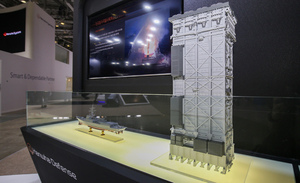
 newsarticleinsiders.com
newsarticleinsiders.com
Babcock press release
The show, co-hosted by the Republic of Korea Navy (ROKN), Busan Metropolitan City and Korea International Trade Association, offers attendees the opportunity to gain insights into naval platforms, maritime defence systems & equipment, marine defence industry products and defence industry related products & technology.
With the development of its assembly, maintenance, repair and overhaul facility in Busan, where the company is assembling Highly-Mechanised Weapons Handling Systems for the ROKN Jangbogo-III submarine programme, Babcock is employing local talent, building local partnerships and growing its supply chain in South Korea. The company has a seven year contract supporting the submarine programme until 2024.
MADEX 2021 provides the perfect platform for Babcock to engage with international delegates about its long-standing experience and innovation in equipment supply, platform design and build, training, consultancy services, naval facility management and in service support.
As well as exhibiting, Babcock delegates also present across a number of topics at the conference and exhibition. This includes Digital Transformation and the Digitally Enabled Ship – where Neil Young, Engineering and Technology Director of Babcock’s Marine Sector will outline Babcock’s integration of digital technologies into naval shipbuilding and transforming data into decision making.
Babcock also joined UK Industry and the Department for International Trade as part of a bespoke UK Pavilion at the show. This promotes UK companies keen to share experiences gained in South Korea and other countries in the region and long-term, strategic industrial partnerships.
Clinton Bixter, Vice President Babcock Korea: “MADEX 2021 is a great opportunity for Babcock Korea to showcase its presence in the region and to promote Babcock’s experience across design and build, technology integration and the in-service support we can offer to a wide range of naval programmes.
“Establishing our Busan base provides us with great access and insight into the South Korean market and the wider region. Our team will be available on-stand to discuss our extensive range of support capability for vessels both above and below the waterline. We look forward to meeting delegates at the show.”
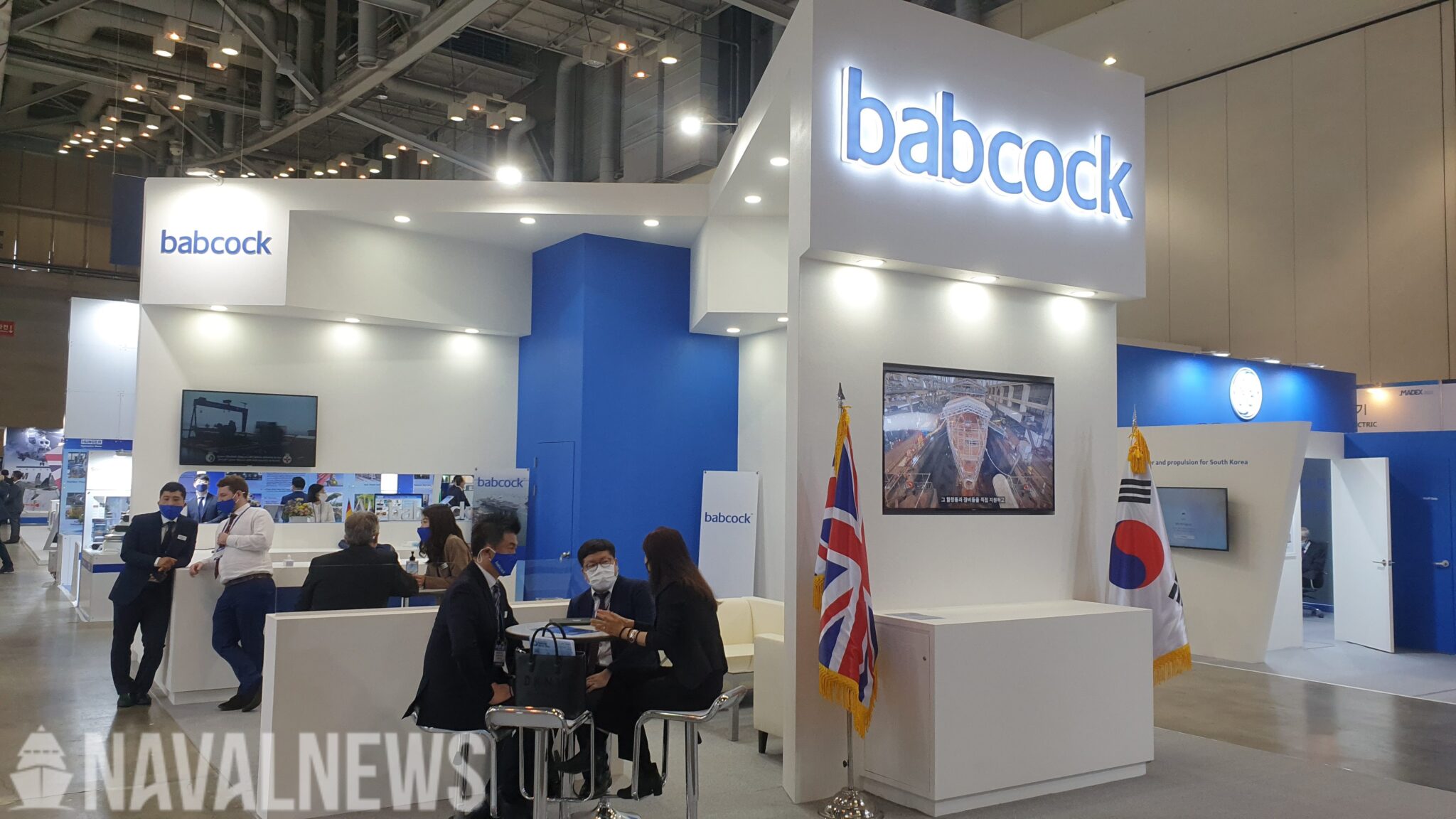
 www.navalnews.com
www.navalnews.com
The 2021 International Maritime Defense Industry Exhibition (MADEX) started on June 9 for a four-day run at BEXCO, with 120 defense companies from seven nations participating.
During the biennial naval defense show, Hanwha Defense noted that it was promoting the Korean Vertical Launch System, or KVLS, as a key item on display.
The KVLS is South Korean Navy’s standard vertical launch system for holding and firing different types of guided weapons, including anti-submarine, anti-air, and anti-surface missiles.
The KVLS features a lower radar cross-section as it is installed under the deck, compared to older launching systems fed from behind by a magazine below the main deck.
Operational with the Navy’s guided-missile KDX destroyers, including the Sejong-the Great-class known as KDX-III and newer Daegu-class frigates, the KVLS was jointly developed by the state-funded Agency for Defense Development and Hanwha.
An upgraded variant of the KVLS, the KVLS-II, is also being developed by Hanwha Defense itself. The new system is to grow in size, and capable of launching newly-developed guided missiles, according to Hanwha.
Also on display was a lithium-ion battery to be used on the new 3,000-ton class attack submarine codenamed KSS-III Batch-2 to enter service by 2026.
Of note is that the Hanwha-built lithium-ion battery has been designed with a top priority on safety and reliability since the battery power stacks have undergone operational demonstrations for the first time in the world, even in various extreme conditions, the firm said.
The submarine-based battery technology has successfully been expanding into a commercial sector to develop an energy storage system, or ESS, for an eco-friendly propulsion system for offshore ships.
Besides naval systems, during the exposition, the Seoul-based company has introduced a range of sophisticated unmanned ground systems, including the multi-purpose unmanned ground vehicle, the explosive ordnance detection, and disposal robot, and the smart grenade robot.

Hanwha Defense showcases advanced techs at MADEX 2021
South Korea’s defense biz bellwether demonstrates naval defense systemHanwha Defense said on June 9 that the firm was showing off its advanced technology durin
Babcock, the Aerospace, Defence and Security company, is showcasing the breadth and depth of its in-service naval support at MADEX 2021 [9-12 June] in the Republic of Korea (South Korea) as the company continues to establish its in–country presence at its facility in the large port city of Busan.
Naval News Staff 09 Jun 2021Babcock press release
The show, co-hosted by the Republic of Korea Navy (ROKN), Busan Metropolitan City and Korea International Trade Association, offers attendees the opportunity to gain insights into naval platforms, maritime defence systems & equipment, marine defence industry products and defence industry related products & technology.
With the development of its assembly, maintenance, repair and overhaul facility in Busan, where the company is assembling Highly-Mechanised Weapons Handling Systems for the ROKN Jangbogo-III submarine programme, Babcock is employing local talent, building local partnerships and growing its supply chain in South Korea. The company has a seven year contract supporting the submarine programme until 2024.
MADEX 2021 provides the perfect platform for Babcock to engage with international delegates about its long-standing experience and innovation in equipment supply, platform design and build, training, consultancy services, naval facility management and in service support.
As well as exhibiting, Babcock delegates also present across a number of topics at the conference and exhibition. This includes Digital Transformation and the Digitally Enabled Ship – where Neil Young, Engineering and Technology Director of Babcock’s Marine Sector will outline Babcock’s integration of digital technologies into naval shipbuilding and transforming data into decision making.
Babcock also joined UK Industry and the Department for International Trade as part of a bespoke UK Pavilion at the show. This promotes UK companies keen to share experiences gained in South Korea and other countries in the region and long-term, strategic industrial partnerships.
Clinton Bixter, Vice President Babcock Korea: “MADEX 2021 is a great opportunity for Babcock Korea to showcase its presence in the region and to promote Babcock’s experience across design and build, technology integration and the in-service support we can offer to a wide range of naval programmes.
“Establishing our Busan base provides us with great access and insight into the South Korean market and the wider region. Our team will be available on-stand to discuss our extensive range of support capability for vessels both above and below the waterline. We look forward to meeting delegates at the show.”

Babcock Builds on its Busan Base at MADEX 2021 - Naval News
Babcock, the Aerospace, Defence and Security company, is showcasing the breadth and depth of its in-service naval support at MADEX 2021 [9-12 June] in the Republic of Korea (South Korea) as the company continues to establish its in–country presence at its facility in the large port city of Busan.
Artist impression of an Arsenal Ship concept. DARPA image.
MADEX 2021: South Korea’s Arsenal Ship Keeping A Low Profile
Not much is yet known about South Korea’s arsenal ship program. During MADEX 2021, the naval defense show which kicked off today in Busan, South Korea, Naval News could not find any official depictions of the ship in the Republic of Korean Navy (ROKN) booth which is almost fully dedicated to the CVX light aircraft carrier project...
Juho Lee 09 Jun 2021According to the ROKN, the ship is currently in the long term conception phase . This means that the design has not been finalized and may change depending on operational requirements in the future.
The limited information available suggests that the ship will have a light displacement of 5,000 tons and carry up to 80 missiles. It will primarily be used for surface strike, but will also carry anti-ship missiles as well as basic air defence systems. It is likely the surface strike element will consist of a mix of the Hyunmoo (현무)-2 ballistic missiles and the Hyunmoo-3 cruise missiles. A total of two to three ships will be built and commissioned in the late 2020s according to a News1 story published last year.
The utility of the arsenal ship for the Republic of Korea Navy has been hotly debated. The debate ultimately comes down to whether or not one views North Korea as the most pressing military threat. Those who do, argue that the South Korean arsenal ship will be an invaluable strategic asset.
According to them, the threat posed by a North Korean first strike on land-based missile bases makes it necessary for South Korea to develop a second strike capability. These bases are easier to target with ballistic missiles, artillery, and even special forces operations. Ship based assets, on the other hand, are significantly more secure against a North Korean attack. This is because North Korea has virtually no long range anti-ship missiles that can be fired from shore.
Safe operating area for the Arleigh Burke class and Zumwalt class. Arleigh Burke class ships can approach North Korean waters almost unopposed. This shows that North Korea has very limited anti-ship missile capabilities. Picture source.
Those who think other neighbouring countries pose a greater security threat cast doubt on the viability of a South Korean arsenal ship. To begin with, they claim such a ship would not be very survivable alone because it will not have any long range air defence capabilities. This means that in a conflict with more capable adversaries than North Korea, the arsenal ship will have to be accompanied by several escorts.
The ROKN already has its hands full escorting its other strategic assets. The burden on the ROKN is likely to grow as it acquires a light aircraft carrier in the early 2030s. Moreover, the loss of a single arsenal ship will lead to a massive reduction in strategic capabilities. Therefore, critics claim the ROKN should reconsider placing all its veritable eggs in a single basket that is unlikely to survive a high intensity conflict.
Arsenal ship funding in question as CVX takes center stage
Doubts also linger as to whether the program will be affordable. At MADEX 2021 the exhibition hall was dominated by aircraft carrier related displays. There were no displays dedicated to the arsenal ship program. ROKN officers declined to comment when Naval News approached them to ask about the arsenal ship.Given the resistance against both the aircraft carrier and arsenal ship program, it seems unlikely the ROKN will continue with both simultaneously. For now, the ROKN seems to be primarily focused on securing funds for its already controversial aircraft carrier, rather than broaching the equally thorny arsenal ship program.

MADEX 2021: South Korea's Arsenal Ship Keeping a Low Profile - Naval News
Not much is yet known about South Korea’s arsenal ship program. During MADEX 2021, the naval defense show which kicked off today in Busan, South Korea, Naval News could not find any official depictions of the ship in the Republic of Korean Navy (ROKN) booth which is almost fully dedicated to the...
MADEX 2021: HHI Unveils HCX-21 Trimaran For Navies And Coast Guards
At MADEX 2021, the naval defense show which kicked off today in Busan, South Korea, local shipbuilder Hyundai Heavy Industries (HHI) unveiled the HCX-21. This trimaran vessel is being proposed in Navy and Coast Guard variants.
Juho Lee 09 Jun 2021Juho Lee story with additional reporting by Xavier Vavasseur
The HCX-21 is a lightweight future surface combatant being designed by Hyundai Heavy Industries. It will have a standard displacement of 1,400 tons, a length of 75 meters, a breadth of 20 meters and a draft of 8.3 meters. It benefits from the technologies and know how acquired by HHI in designing the HCX-19. The “Hyundai Combatant eXperimental 2019” was unveiled at MADEX 2019 to show HHI’s vision of what surface combatants will look like in the 2030ies.
The trimaran hull design of HCX-21 is similar to that of the Independence-class littoral combat ship of the U.S. Navy. The ship will be available in several different configurations. These include, but are not limited to, offshore patrol, antiship, antisubmarine, and unmanned vehicle operations.
“The design is a future proof long term solution. We built in flexibility from the ship’s inception so that it will be able to accommodate advances in technology such as drones and energy weapons. In fact, the entire ship can be reconfigured. We can swap out the gun, the mission bays and even make alterations to the aft deck area to tailor the ship to our customer’s needs, ranging from high-intensity warfighting to patrol duties,” said an HHI representative in an interview with Naval News. He stressed however that the ship is still in the concept design phase. “We expect it to be ready by the late 2030s.”
It is hoped that the ship will bring high technology capabilities at an affordable price.
“Although we welcome all customers, we expect our primary market to be countries in the Middle East, Southeast Asia, and South America. Those countries looking to quickly augment their naval warfare capabilities at a low price will find this asset very valuable.”
HHI representative
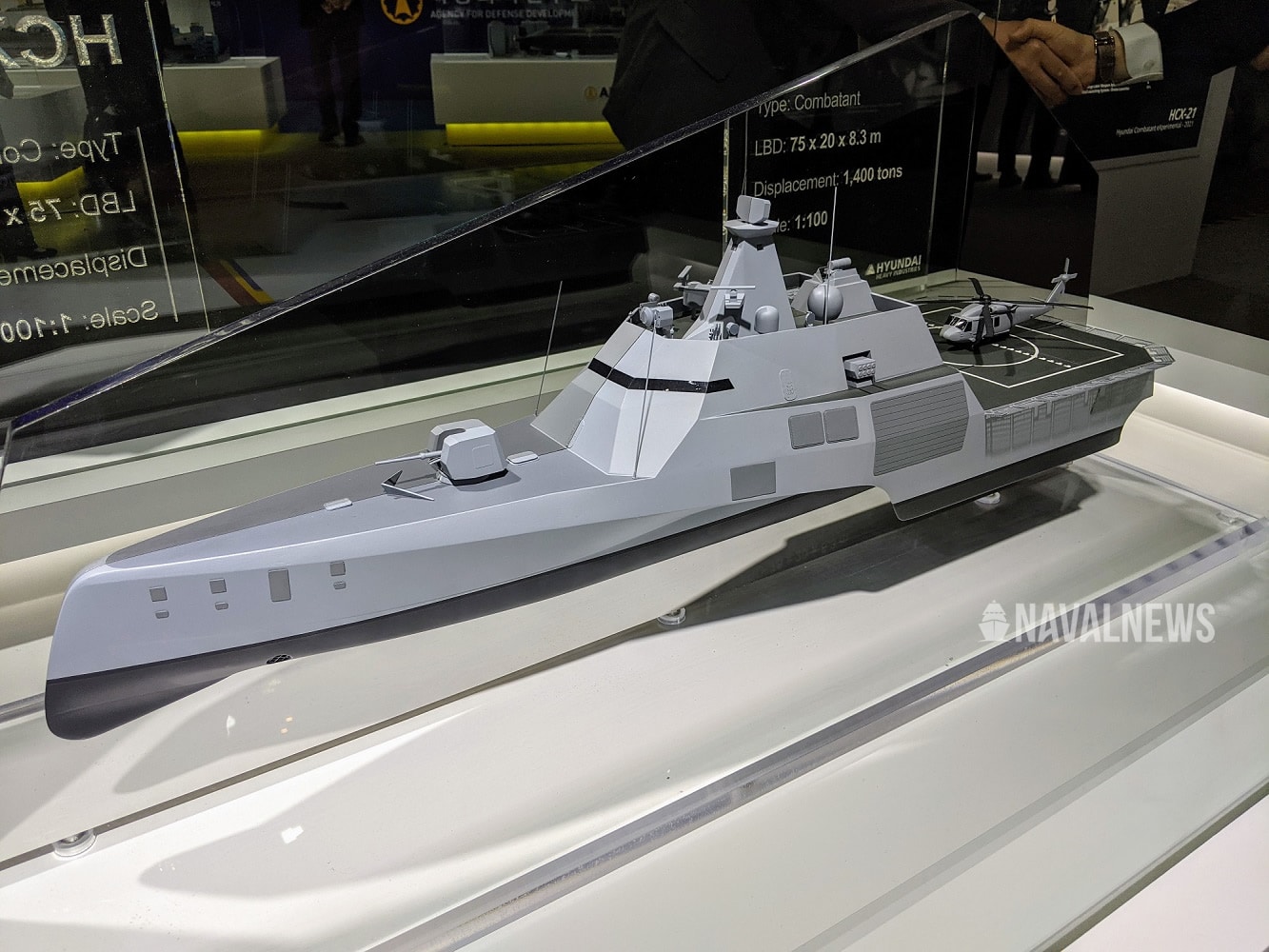
MADEX 2021: HHI Unveils HCX-21 Trimaran for Navies and Coast Guards - Naval News
At MADEX 2021, the naval defense show which kicked off today in Busan, South Korea, local shipbuilder Hyundai Heavy Industries (HHI) unveiled the HCX-21. This trimaran vessel is being proposed in Navy and Coast Guard variants.
MADEX 2021: DSME, HHI display competing carrier designs for RoKN's CVX project
by Gabriel Dominguez & Dae Young KimSouth Korean companies Daewoo Shipbuilding and Marine Engineering (DSME) and Hyundai Heavy Industries (HHI) displayed competing designs for the Republic of Korea Navy's (RoKN's) light aircraft carrier programme during the 9–12 June International Maritime Defense Industry Exhibition 2021 (MADEX 2021) in Busan.
DSME showcased a 1:125 scale model of its proposal for the RoKN's ‘CV eXperimental' (CVX) project that features a twin-island arrangement but no ‘ski jump' ramp. The model displayed reflects the design that has been seen in promotional material released by the RoKN since January.
According to the company, the proposed carrier would be 263 m long, 46.6 m wide, and have a displacement of 45,000 tons and a top speed of 27 kt. It would be capable of carrying up to 16 short take-off and vertical landing (STOVL) fighter aircraft, such as the Lockheed Martin F-35B Joint Strike Fighter, on its flight deck and 12 more in its hangar.
Meanwhile, HHI displayed a 1:400 scale model of its proposed carrier, which would be 270 m long and 60 m wide. The design also features a twin-island arrangement but comes with an optional ‘ski-jump' configuration. The model, which is also configured with a well deck, features an area at the stern, below the level of the flight deck, for operating rotary unmanned aerial vehicles (UAVs).
According to HHI, the carrier would have a full-load displacement of 45,000 tons and be capable of carrying a maximum of 16 F-35Bs on its flight deck and a further eight in its hangar.
MADEX 2021: DSME, HHI display competing carrier designs for RoKN's CVX project
South Korean companies Daewoo Shipbuilding and Marine Engineering (DSME) and Hyundai Heavy Industries (HHI) displayed competing designs for the Republic of Korea Navy's...
Also on display was a lithium-ion battery to be used on the new 3,000-ton class attack submarine codenamed KSS-III Batch-2 to enter service by 2026.
Of note is that the Hanwha-built lithium-ion battery has been designed with a top priority on safety and reliability since the battery power stacks have undergone operational demonstrations for the first time in the world, even in various extreme conditions, the firm said.
The submarine-based battery technology has successfully been expanding into a commercial sector to develop an energy storage system, or ESS, for an eco-friendly propulsion system for offshore ships.
MADEX 2021: DSME Unveils Its CVX Light Aircraft Carrier Design
Daewoo Shipbuilding and Marine Engineering Co., Ltd (DSME) revealed its planned light aircraft carrier, called CVX, which reportedly meets operational needs for the Republic of Korea Navy (ROKN) during MADEX in Busan, on June 9th, 2021.
Daehan Lee 10 Jun 2021Daehan Lee story with additional reporting by Xavier Vavasseur
According to DSME, their CVX is 45,000 tons with a crew complement of 1,400 sailors and maximum sailing speed of 27 knots. It features a flat deck unlike the ski-jump-based aircraft carrier proposed by Hyundai Heavy Industries (HHI).
A Senior Engineer from HHI commented that the DSME is actually 38,000 tons because DSME wrote the loaded displacement tonnage, but DSME’s Principal Engineer and General Manager emphasized practicality of the CVX construction, noting that its carrier model reflects maritime strategic needs and requirements that the ROKN has demanded to shipyards. Following interviews with the ROK Navy and DSME, the Korean Navy’s demands include both helicopters and fixed wong operations, and space efficiency without a ski-jump to load more jets and helicopters onboard.
The manager and engineer of DSME expected that its CVX could accommodate 12 and 16 jets respectively in its hangar and on the flight deck. Similar to HMS Queen Elizabet with her characteristic two ‘islands’ design (the bridge located forward and the flyco for flight operations aft). The carrier could operate the other bridge as a back-up in case of emergency when one of the two bridges is compromised, according to the Principal Engineer.
DSME told Naval News that two CIWS (close-in weapon system) will be fitted aboard CVX. One will be installed at the stern and one at the bow of the carrier, along with localized anti-air KVLS (Korean Vertical Launching System) system behind the second island, at the stern. It was also confirmed by the General Manager that DSME was provided with technical aide from British company Babcock and Italian company Fincantieri during the initial design phase of the carrier, especially in finding solutions to connect aircrafts onboard with the mother ship.
On the first day of MADEX 2021, a Memorendum of Understanding (MOU) was signed between DSME and Fincantieri for support to the conceptual design for the CVX project. Talking to Naval News, Italian Navy Admiral Dario Giacomin, Vice Secretary General of Defence and Vice National Armament Director said:
“Italy is a leading country in the defense sector, Italian shipyards are cutting hedge for major surface combatants ships (like DDX and FFG) submarines and submarine rescue ships, logistic support ships) and in particular in the projecting and building light aircraft carrier. Italy is the only nation that built 3 different carriers in the last 30 years. ITS Cavour recently completed the carrier qualification in the US for operating F35B. ITS Trieste (currently under final construction phase) is already fit and ready for F35B.
Fincantieri is the italian defence shipyard Champion, made and makes this possible with a state of art project capability and outstanding construction skills. All in full and strict cooperation and sinergy with the Italian Navy”
The ROKN explained that types of helicopters for a planned carrier have not been decided yet, but DSME showed confidence that its proposed CVX can load any helicopters available such as Wildcat, Marine One, MH-60R etc. Both DSME and the Korean Navy denied the ongoing speculation that there has been a request to convert the KFX (Korean Fighter eXperimental) prototype, KF-21 for the CVX, because it is currently land-based and would substantially require more time for such a change and development of proper engines.
They also flatly expressed budgetary concerns when asked if there is a possibility of increasing the carrier tonnage. However, another representative from the DSME booth implied that the ROKN and the shipbuilding industries started working on the blueprint of light aircraft carriers first to acquire technical basis and operational capabilities, even though they already found out in their research in 2015 that a mid-sized CVX would be more efficient to operate aircrafts.
DSME concluded by stressing that its CVX blueprint meets maritime needs of the ROK Navy by enabling not only flight operations, but also amphibious assaults based on support of helicopters, emphasizing its competitiveness while pointing out that HHI’s proposed carrier lacks key function for future warfares: anti-drone system (the DSME design features anti-drone defense systems), the number of helicopter spots (only 6 compared to 9 in the DSME design), with arguably wrong location of phased array radar under the wheelhouse of the bridge, which could hinder detection of inbound hostile aircrafts.
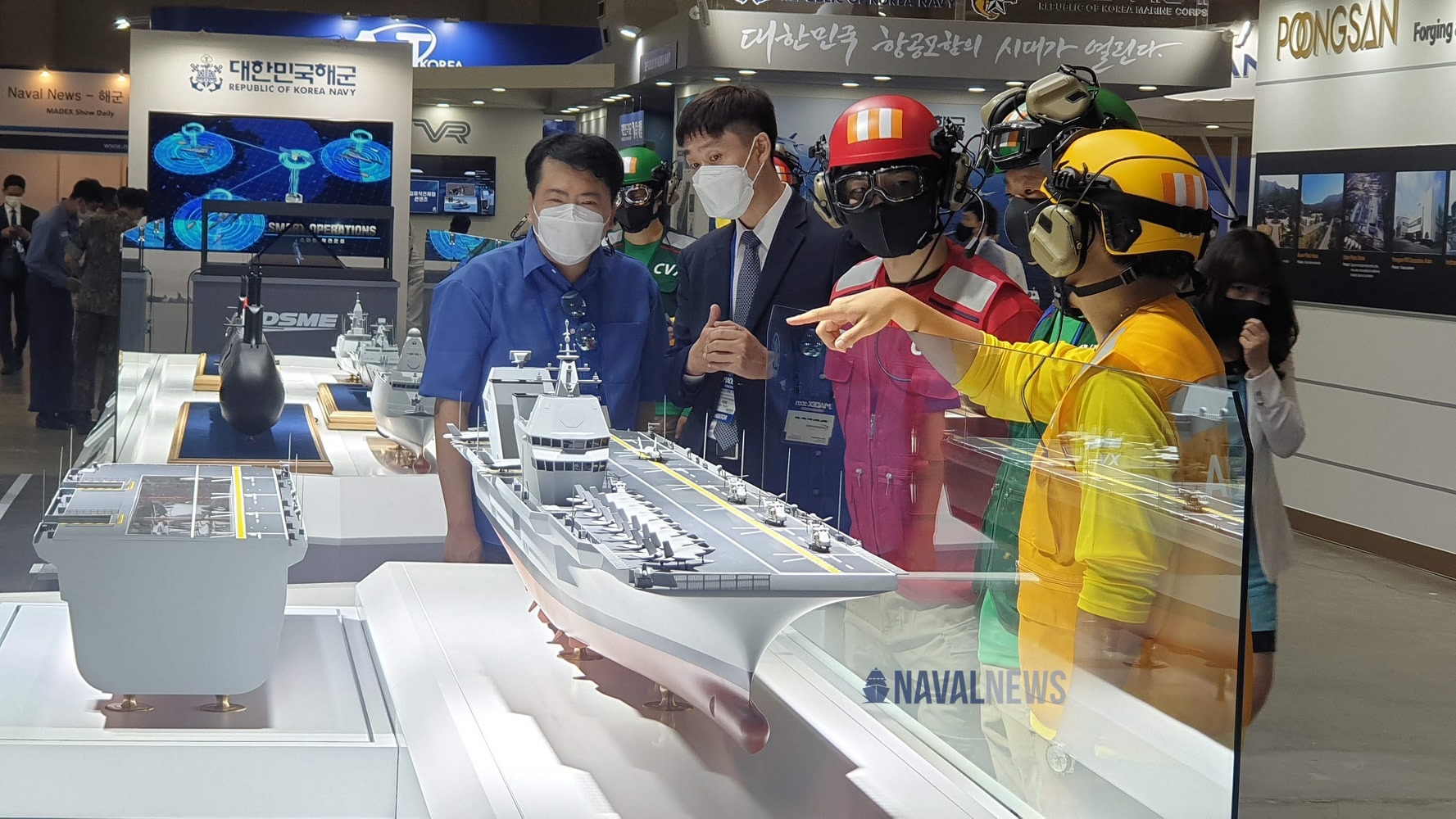
MADEX 2021: DSME Unveils its CVX Light Aircraft Carrier Design - Naval News
Daewoo Shipbuilding and Marine Engineering Co., Ltd (DSME) revealed its planned light aircraft carrier, called CVX, which reportedly meets operational needs for the Republic of Korea Navy (ROKN) during MADEX in Busan, on June 9th, 2021.
MADEX 2021: Fincantieri To Support DSME For CVX Conceptual Design Phase
During MADEX (International Maritime Defense Industry Exhibition) 2021, one of the main naval exhibitions in the Asia Pacific area, Fincantieri has signed a contract with Daewoo Shipbuilding & Marine Engineering (DSME) to support the Conceptual Design of the new class of aircraft carriers “CVX” for the Navy of the Republic of Korea (South Korea).
Naval News Staff 10 Jun 2021The program relating to the first-in-class unit envisages the tender for the Basic Design starting from the second half of 2021, whereas the detail design and construction will begin in the following years.
The signing took place between Jung Woo Sung, Vice President Naval & Special Ship Marketing Division of DSME, and Marco Cerruti, Regional Sales Manager of Fincantieri, in the presence of Federico Failla, Italian Ambassador in Seoul, Vice Admiral Dario Giacomin, Deputy Defense General Secretary – Deputy National Armament Director, and Rear Admiral Antonio Natale, Advisor of the Chief of Staff of the Italian Navy.
Fincantieri will advise DSME based on the expertise gained with the construction of the LHD (Landing Helicopter Dock) “Trieste”, which will be delivered next year to the Italian Navy. With this agreement, Fincantieri strengthens its presence in the country, further boosting the relationship with the Republic of Korea. In fact, through its subsidiary Seastema, the Group is cooperating in the construction of eight new Daegu class frigates (FFX-II) for the national Navy, providing SEASNavy, an innovative integrated platform management system (IPMS).
Talking to Naval News, Italian Navy Admiral Dario Giacomin, Vice Secretary General of Defence and Vice National Armament Director said:
“Italy is a leading country in the defense sector, Italian shipyards are cutting hedge for major surface combatants ships (like DDX and FFG) submarines and submarine rescue ships, logistic support ships) and in particular in the projecting and building light aircraft carrier. Italy is the only nation that built 3 different carriers in the last 30 years. ITS Cavour recently completed the carrier qualification in the US for operating F35B. ITS Trieste (currently under final construction phase) is already fit and ready for F35B.
Fincantieri is the italian defence shipyard Champion, made and makes this possible with a state of art project capability and outstanding construction skills. All in full and strict cooperation and sinergy with the Italian Navy”
The signing of this contract marks an important step for the Group in establishing a strategic cooperation with DSME. In a country with high naval shipbuilding capabilities, such cooperation might provide significant supplies for this unit and it might be extended to other products or sectors in the future. The “Trieste” unit’s design represents the state-of-the-art for this class of ships, in addition to being a well-proven product fully meeting the operational requirements of the Korean Navy. With the LHD, Fincantieri has proven its ability to design and build highly innovative units which represent a benchmark in the international scenario.
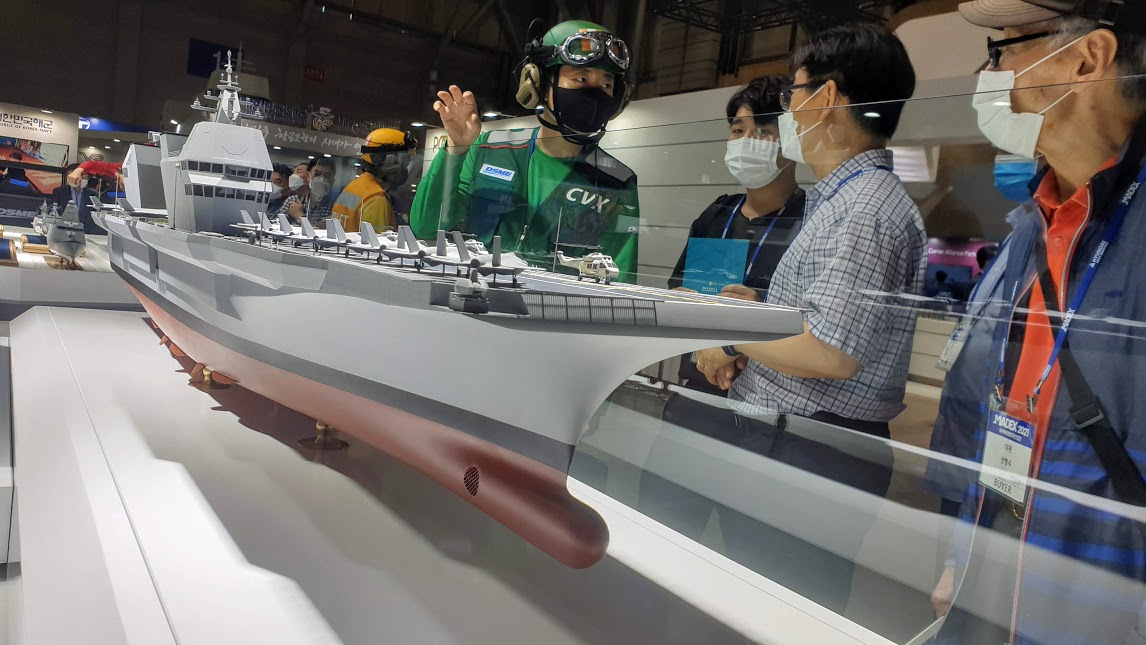
MADEX 2021: Fincantieri to support DSME for CVX Conceptual Design Phase - Naval News
During MADEX (International Maritime Defense Industry Exhibition) 2021, one of the main naval exhibitions in the Asia Pacific area, Fincantieri has signed a contract with Daewoo Shipbuilding & Marine Engineering (DSME) to support the Conceptual Design of the new class of aircraft carriers “CVX”...
Rolls-Royce to showcase future South Korean naval power and propulsion
Rolls-Royce is this week showcasing future naval power and propulsion capabilities at South Korean Defence exhibition, MADEX.
The new power and propulsion model will be on display, demonstrating Rolls-Royce’s extensive capabilities for both Integrated Full Electric and Hybrid Electric Propulsion solutions for modern naval vessels.
Rolls-Royce already has proven experience with the Republic of Korea Navy (RoKN), having introduced a revolutionary, modern and simple, hybrid propulsion system arrangement for all eight ships in the Daegu-class FFX Batch II Anti-Submarine Warfare frigate programme – each powered by a single MT30 gas turbine and electric propulsion motors powered by four Rolls-Royce MTU diesel generators per ship. A similar system arrangement has more recently been selected for the Ulsan-class programme.
Beyond the FFX programme, Rolls-Royce is the only manufacturer in the world that has provided naval marine gas turbine generators into front-line integrated full electric (IFEP) powered destroyers and aircraft carriers. Rolls-Royce has extensive and proven experience in IFEP powered warships. The Royal Navy’s Type 45 destroyers are powered by Rolls-Royce’s WR-21 engines. Two MT30 main gas turbine generator sets and two Rolls-Royce RR4500 auxiliary turbine generator sets supply 78MW of total ship power to U.S. Navy’s Zumwalt-class destroyers. The Royal Navy’s Queen Elizabeth-class aircraft carriers, due to visit South Korea later this year, combine two MT30 36MW gas turbine alternators with four medium speed diesel generators delivering 112 MW of electrical power.
The power density of the proven marine MT30 gas turbine genset is also one of the key enablers for Integrated Full Electric Propulsion (IFEP) for the next - generation RoKN destroyer (KDDX). MT30 alone is delivering huge design benefits through its power density, significantly reducing the number of gas turbines required to power advanced naval platforms.
Jay Lee (Jongyel Lee), Vice President of Business Development & Future Programmes, Defence – Naval, Korea said: “Rolls-Royce remains at the forefront of naval propulsion technology. Our advanced naval power capabilities are powering many of the world’s most advanced platforms in all conceivable propulsion configurations and importantly support the Republic of Korea Navy’s SMART Navy Vision. We are delighted to be showcasing our capability at MADEX this year, through our new power and propulsion model. We look forward to having an opportunity to build on the important relationships with our customers including the Republic of Korea Navy.”
“Selecting the right power and propulsion system is one of the most important decisions our customers will face when designing their new platforms. We are committed to working closely with the Republic of Korea Navy to provide them with the most adaptable propulsion systems based on the most modern technology available today. This will ensure our customers can retain their military advantage via future technology insertion without having to endure costly upgrades to legacy power generation capability throughout the life of their ships.”
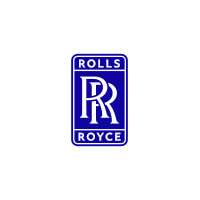
Rolls-Royce to showcase future South Korean naval power and propulsion
Rolls-Royce to showcase future South Korean naval power and propulsion
MADEX 2021: Lacroix from France introduces its latest generation of Sealem-Sealir ammunition
At MADEX 2021, International Maritime Defense Industry Exhibition in South Korea, French company Lacroix introduces its latest generation of Sealem-Sealir ammunition and presents the associated decoy launching system SYLENA.The MADEX 2021 naval defense trade show is an opportunity for exhibitors and visitors to discuss naval programs and equipment with local shipyards and system providers, to meet with the Korean Navy and program procurement bodies, as well as with high-level delegations, including foreign ones. The event takes place in Busan (South Korea), as part of a broader "Marine Week" event from 9 to 12 June 2021.
At MADEX 2021, French Company Lacroix presents its full range of naval solutions (SYLENA, LW, MK1, MK2, DAGAIE, K-RBOC) that meet all the operational needs for self-protection of naval platforms of all types (OPV, frigates, corvettes and large ships).
For more than 10 years, the Lacroix company has developed the latest generation of Decoy Launching Systems to meet world navies' requirements: as the SYLENA LW, SYLENA MK1 and SYLENA MK2.
From patrol boats to frigates, the SYLENA range of systems has been developed by Lacroix to offer an optimized solution for ship protection with RF and IIR (Imaging Infrared) SEACLAD decoy effects. Unlike many Decoy Launching Systems which deploy chaff, regarded as outdated with respect to modern electric warfare due to chaff discrimination systems, SYLENA utilizes corner reflector (CNR) technology.
The SYLENA launchers are fully compatible with corner reflectors (CNR) and Lacroix RF decoys are based solely on this technology: Lacroix does not mix CNR with chaff, in order to preserve the credibility of the decoy.It offers omnidirectional (360°) protection and is effective whatever the missile's relative bearing, thanks to the omnidirectional characteristics of its decoy. For anti-torpedo tactics, SYLENA MK2 offers a smart solution with the ability to deploy the SEALAT-CANTO® anti-torpedo decoy.

MADEX 2021: Lacroix from France introduces its latest generation of Se
At MADEX 2021, International Maritime Defense Industry Exhibition in South Korea, French company Lacroix introduces its latest generation of Sealem-Sealir
Didn't like the idea of fixed-face AESA placed on top of the CIWS, it has no purpose and contradicts with the methodology of using fixed face AESA.LIG Nex1 heads to MADEX 2021 to win Navy’s CIWS-II project
LIG Nex1 will participate in the International Maritime Defense Industry Exhibition 2021 to showcase its advanced close-in weapons system, or CIWS, specialized to the South Korean Navy.
Currently, the Navy is using a Dutch CIWS called Goalkeeper, which automatically shoots thousands of bullets per minute to offer short-range defense for ships against fast-moving missiles, aircraft and surface vessels.
Through its CIWS-II program, the Navy aims to develop a more advanced CIWS that has the same barrel and ammunition carriage system as Goalkeeper.
At MADEX 2021, which will be held from Wednesday to Saturday at Bexco in Busan, LIG Nex1 will introduce a Korean-made Goalkeeper. If selected for the Navy’s CIWS-II program, LIG Nex1 will supply its Goalkeeper to the Navy’s future vessels including light aircraft carrier, next-generation KDDX destroyers and FFX-III frigates.
Last September, LIG Nex1 completed a depot maintenance and acceptance test of its Goalkeeper. It is also the first Korean company to have secured a fire control system dedicated to CIWS-II.
“LIG Nex1 has the technological expertise on ship-to-ship guided weapons, which will be targets of CIWS-II. Also, LIG Nex1 has the expertise on rolling airframe missiles and anti-ship guided missiles ‘Haegung,’ so we are confident of a successful development,” a company official said.

LIG Nex1 heads to MADEX 2021 to win Navy’s CIWS-II project
LIG Nex1 will participate in the International Maritime Defense Industry Exhibition 2021 to showcase its advanced close-in weapons system, or CIWS, specializedwww.koreaherald.com
It will be better if the AESA placed elsewhere on a fixed mast linked to two individual CIWS with their own tracking systems (Radar + E/O)
A new design for CVX, South Korea’s light aircraft carrier program, was revealed by Hyundai Heavy Industries (HHI) at MADEX 2021. The new design is significantly different from both HHI’s own previous design and Daewoo Shipbuilding & Marine Engineering (DSME)’s current design.
Juho Lee 10 Jun 2021The new design has an empty displacement of 30,000 tons. Despite this, the ship is 60 meters in width, 270 meters in length and has a 260 meter flight deck. This means that it is significantly longer than, but has a similar displacement to, previous designs.
“We can keep the displacement low because we redesigned the lower part of the ship. Our previous version has a thicker hull,” said an HHI representative who was interviewed by Naval News.
“This does sacrifice internal capacity somewhat. However, the negative effects are more than made up for by the increased length, as well as, the speed and stability that we gain from the design.”
Like the previous design, the ship is capable of carrying 16-20 F-35B fighters, as well as helicopters. “We’re still able to easily alter the flight complement to carry out amphibious assault operations. We can fit more than thirty helicopters if we need to.”
The ship features twin islands and two aircraft elevators on either side of the flight deck. The first island will be in charge of overall operations, while the second island will carry out flight control duties. Moreover, the X-shaped design of the new islands provide unique advantages according to the representative.
The front island with the new X-shaped design. The AESA radar has been installed on the lower part of the island, unlike in previous designs.
“They provide a significant degree of stealth, reducing the ship’s overall radar cross section. It also allows us to install the ship’s AESA radar lower down on the island. This is because the part of the island where the radar will be installed is slanted, meaning that the radar will not be hampered by clutter from flight operations. This frees more room for a multitude of sensors on top of the island,” the representative explained.
According to him, the design allows for more efficient flight control as well. “Flight control makes up the upper X shape, which means flight control operators have great visibility of the flight deck”.
Another interesting feature of the HHI design is the focus on unmanned systems. The new design was built with the operation of such systems in mind from the very outset.
The stern area features a special flight deck for unmanned aerial vehicles (UAV) that take off vertically. There are 16 KVLS cells next to the UAV flight deck. The ship also has a mini-well deck for unmanned underwater vehicle and unmanned surface vehicle operations.
The most eye-catching new feature of this design is the ski-jump. “We tried to take onboard the domestic criticism regarding the light aircraft carrier design,” explained the representative, referring to the recent controversy that has been generated by the CVX program.
The ski-jump allows the F-35B to take off more easily while fully-loaded. The representative told us that this will lead to higher sortie rates. “Sortie rates depend on many variables, such as wind, humidity etc. Having a ski-jump allows us to be influenced less by these conditions when it comes to flight operations.” Moreover, the ski-jump coupled with the long flight deck allows the carrier to be easily converted for short take off but arrested recovery (STOBAR) operations.
“We built in growth potential from the very beginning. If we install an angled flight deck and arresting wire for when aircraft land, the ship can be configured for STOBAR”.
Despite this, the representative emphasized that a conversion to catapult assisted take off but arrested recovery (CATOBAR) would be difficult. “The catapult system requires a lot of energy to operate, so without a major overhaul of the propulsion system itself, conversion to CATOBAR is unlikely.”
Some claim it is unclear whether a ski-jump is the optimal design for higher sortie rates. “We are also conducting research on adding a ski-jump, although that is not currently in the Republic of Korea Navy (ROKN)’s operational requirements,” a DSME representative told Naval News.
According to him, the primary advantage of the ski-jump is that it allows F-35Bs to take off while using less of the runway. “However, this does not necessarily translate to higher sortie rates because the addition of the ski-jump would make the flight deck more congested,” explained the representative. “More research will have to be done to see which one is the most efficient design. We are ready to change the design if operational requirements change.”
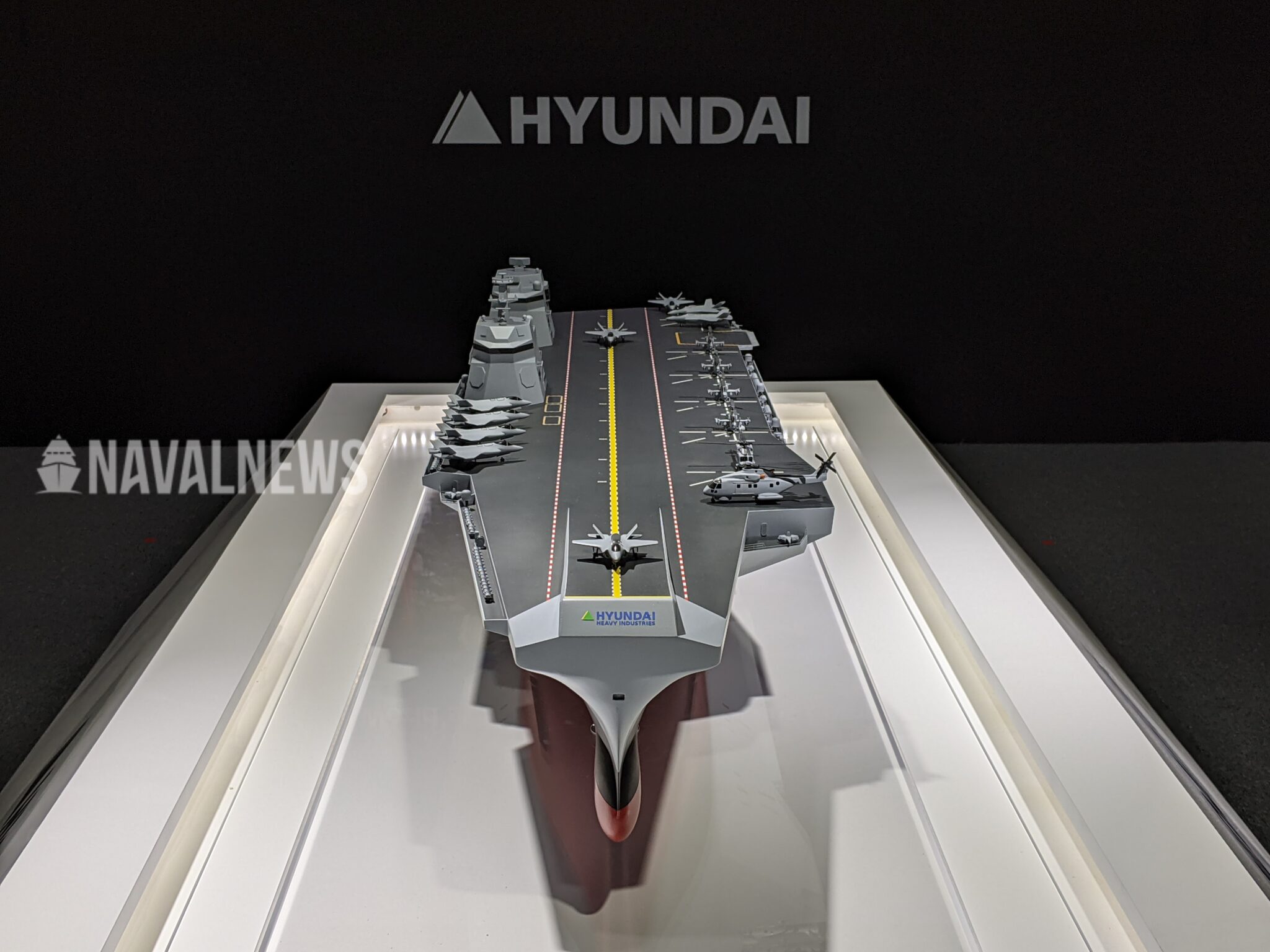
MADEX 2021: HHI unveils new CVX Aircraft Carrier design - Naval News
A new design for CVX, South Korea’s light aircraft carrier program, was revealed by Hyundai Heavy Industries (HHI) at MADEX 2021. The new design is significantly different from both HHI’s own previous design and Daewoo Shipbuilding & Marine Engineering (DSME)’s current design.
Day 2 at MADEX 2021, the maritime defense exhibition held in Busan, South Korea. In this video we focus on South Korean latest weapon systems such as Close in weapon system (CIWS) II, Korean Vertical Launch System (KVLS) II as well as DSME' submarine designs and their proposal to the Philippine Navy.
MADEX 2021: HHI Unveils HDP-1500 Neo OPV
At MADEX 2021, the maritime defense exhibition currently held in Busan, South Korea, local shipbuilder Hyundai Heavy Industries (HHI) unveiled the HDP-1500 NEO Offshore Patrol Vessel (OPV).
Xavier Vavasseur 11 Jun 2021The HDP-1500 Neo is the export variant of a new OPV design developed by HHI for the Republic of Korea (ROK) Navy. According to HHI, the ship is “based on decades of know-how, experience and latest shipbuilding technologies”.
We tried to make our product as competitive as possible by bringing the price down
Gabriel Kim, Sale Associate at HHI
The vessel features a stealth design with a clean superstructure for reduced radar cross section (RCS) signature. The optimized and simplified internal layout provides better crew habitability. With its extended range (5,500 nautical miles) and endurance (28 days at sea), the OPV can cover wide area of water.
Artist impression on HHI’ stand at MADEX 2021 showing the new OPV sailing alongside the new trimaran
Reconfigurable spaces below the helicopter deck can accommodate mission modules for various missions:
- Patrol and protection of coastal borders and EEZ
- Anti-smuggling and anti-piracy
- Humanitarian assistance & disaster relief, search and rescue
- Anti-Surface Warfare operations
The ship is suited for a crew of 41 members and has extra beds for 10 people, such as the aircrew. Weapon systems include a main gun of up tot 76 mm and up to four CIWS.
“She can be equipped with one mid-size helicopter. Underneath the helideck, there is enough space for four mission modules, so they can be used for a variety of missions“.
Taking about potential costumers, Kim said HHI “is marketing this ship to navies in the South America and also for Asian countries and Middle-Eastern countries as well“.
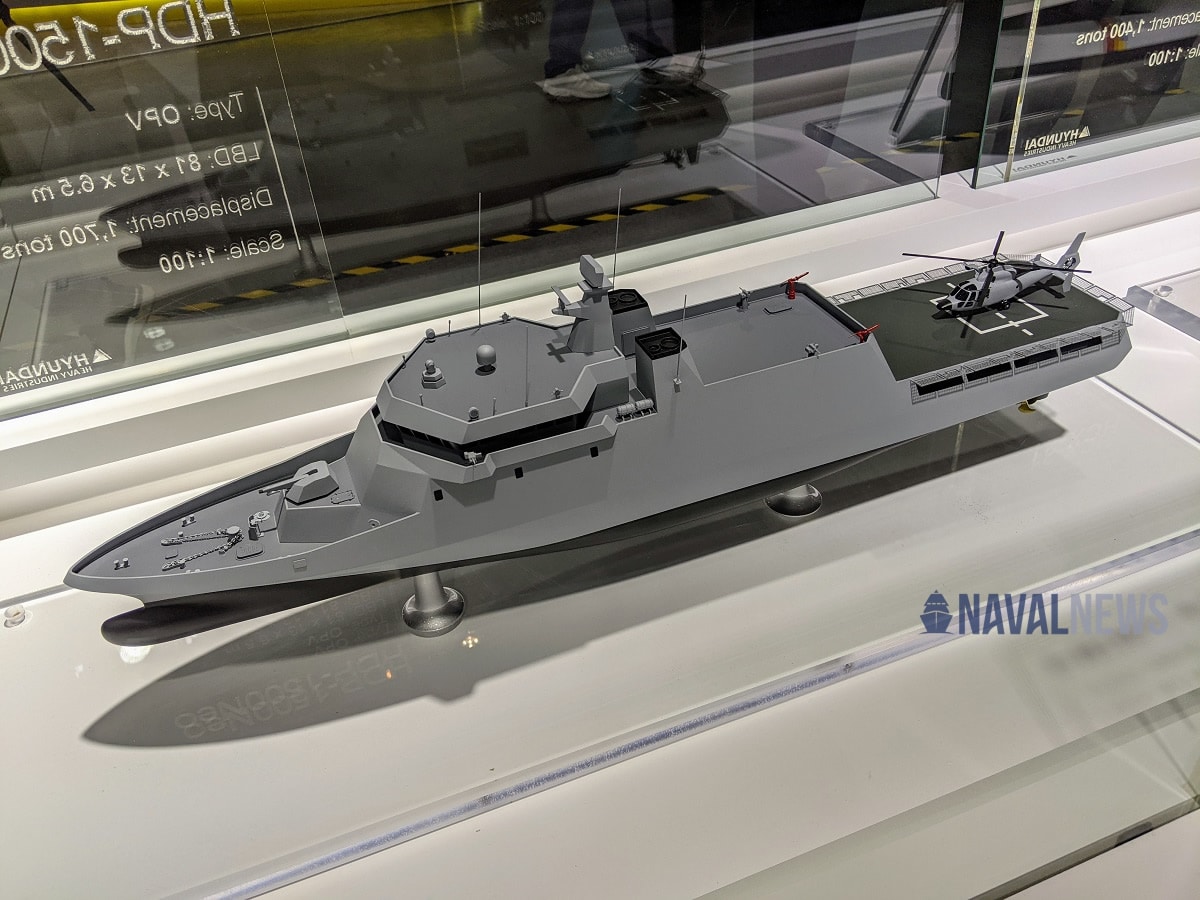
MADEX 2021: HHI Unveils HDP-1500 Neo OPV - Naval News
At MADEX 2021, the maritime defense exhibition currently held in Busan, South Korea, local shipbuilder Hyundai Heavy Industries (HHI) unveiled the HDP-1500 NEO Offshore Patrol Vessel (OPV).
MADEX 2021: Update On ROK Navy’s KDX-II Performance Improvement Project
During MADEX 2021, the naval defense show currently held in Busan, South Korea, Naval News learned the latest on the Republic of Korea (ROK) Navy KDX-II destroyer Performance Improvement Project (PIP). The ROK Navy has six Chungmugong Yi Sun-sin-class destroyers in its fleet. There were commissioned between 2003 and 2008.
Daehan Lee 11 Jun 2021It was determined that KDX-II (Korea Destroyer Experiment) improvement project will be proceeded after improving the Gwanggaeto the Great-class destroyers (KDX-I), in contrast to the previous assumption that KDX-II upgrade would begin in 2018. This decision was made on the reason that the general update of the current KDX-II would negatively affect the ongoing plan to acquire the next-generation destroyer project which will be completed with Korean technology without any foreign assistance until mid-2030s, KDDX (KDX-IV), also called as “Korean Aegis” by the press.
In accordance with such a concern, the three 3,200 tons KDX-I destroyers, the flagships of each fleet in three seas around the Korean Peninsula since 1998, are being updated with the localized combat system software and new sensors. The destroyer Yangmanchun completed the capability improvement first in 2020, followed by the other two destroyers, Ulchi Mundok and Gwanggaeto the Great.
Unlike the KDX-I ships, KDX-II are 5,500t stealthy destroyers for operations in blue waters, fitted with the SM-2 Blocks 3/A surface-to-air missiles. It formed the concept of multi-layered air defense system for the first time in the world. A Chungmugong Yi Sun-sin-class destroyer is deployed near African waters twice a year as the Somali Sea Escort Task Group, called Cheonghae Unit. It has been one of the largest naval ships that the ROK Navy possesses with three-dimensional radars, MW-08.
However, the class was criticized for the lack of operational capabilities, particularly due to the limited number of simultaneous target engagement and firing range. The MW-08 radar was scheduled to be replaced by the Korean LIG Nex1’s SPS-550K which is installed on Incheon-class frigates, but it turned out by the Korean Navy that the replacement of its mast and radar would be technically and financially impossible because the SPS-550K is incompatible with the SM-2 missiles and the ships’ structure should be totally modified.
The analysis of the military and local media pointed out that such major replacement of onboard systems would require another complete overall change of KDX-II design which will approximately cost more than 1 billion dollar (1 trillion KRW), indicating that it would be much better to acquire new destroyers instead. The Defense Acquisition Program Administration (DAPA) and the Navy thus decided to focus on upgrading the anti-submarine warfare capability by changing its Towed Array Sonar System (TASS). Then, in the 133th Defense Project Committee on February 22nd in 2021, the DAPA changed the plan by additionally including the upgrade of KDX-II combat system based on domestic research and development. This changed schedule will last from 2022 to 2031, and the cost estimate is around 4.2 billion dollar (470 billion KRW).
Image on display on Hanwha Systems stand at MADEX 2021 showing the planned upgrade of the KDX-II combat system in a few years
As the DAPA already announced to develop next-generation destroyers in the KDDX project with Hyundai Heavy Industries (HHI) to ensure cost-efficiency, operational capabilities, and level of technical completion, the Korean local media interpreted that 6 KDDX will gradually replace the current KDX-II ships and the ROK Navy confirmed that a few of them will be assigned to its aircraft carrier flotilla in the future.
Talking to Naval News during MADEX 2021, a Junior Engineer of HHI who is specialized in surface ships planning, the DAPA has still been reviewing its business feasibility study as a lot of assets equipped on KDX-II destroyers were originally imported from foreign defense companies such as Thales and American defense firms. Thus, he added that the key goal of the KDX-II upgrade will be to develop alternative localized systems to lessen foreign dependence on defense capabilities.
However, when asked which option HHI would choose between improving the current TASS only or upgrading the destroyers generally, the engineer denied to answer by saying that details of the KDX-II improvement have not been specified yet, and that we would have to wait to know a fixed, specific date for such an update. An interview with him also confirmed that the upgrade agenda keeps changing its specifics due to other important businesses, although it is often said in his HHI meetings that it might begin soon.
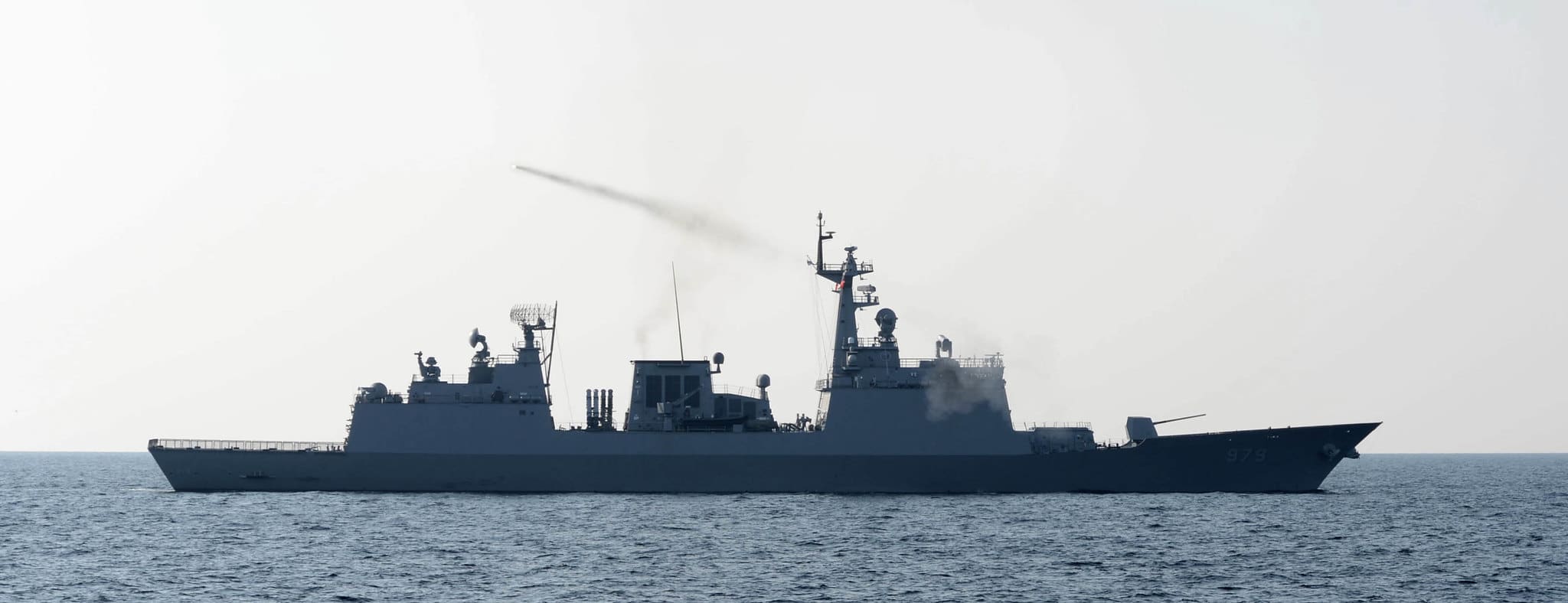
MADEX 2021: Update on ROK Navy's KDX-II Performance Improvement Project - Naval News
During MADEX 2021, the naval defense show currently held in Busan, South Korea, Naval News learned the latest on the Republic of Korea (ROK) Navy KDX-II destroyer Performance Improvement Project (PIP). The ROK Navy has six Chungmugong Yi Sun-sin-class destroyers in its fleet. There were...
MADEX 2021: LIG Nex1 Unveils Its CIWS-II For ROK Navy
Korean company LIG Nex1 unveiled its CIWS-II (close-in weapon system) design during MADEX 2021 naval defense exhibition currently held in Busan. LIG Nex1 is specialized in localized naval assets including sonars, sensors, missiles, and other assets for the Republic of Korea Navy (ROKN).
Daehan Lee 11 Jun 2021Benchmarking SGE-30 Goalkeeper produced by Signaal (now known as Thales Netherland) the ROKN requested to develop Korean close-in weapon system, since the U.S.-made Phalanx from Raytheon, which was introduced to the Korean Navy after the Dutch SGE-30 Goalkeeper was discontinued, had a difficulty defending ships from supersonic anti-ship missiles, and required high maintenance and had acquisition costs despite of its proved reliability. Accordingly, the two representative local companies, Hanwha Defense and LIG Nex1, have been competing each other to win the heart of the ROKN and to alternate Phalanx currently used by ROKN ships.
Before beginning his briefing on the CIWS-II, the Chief Manager of LIG Nex1, Kwan-soo Kim, first told Naval News at 2021 MADEX on June 10th that his company is proud to publicly announce the success of localizing numerous key naval technologies for the ROKN and the Marine Corps over years, which has always been believed to be the most difficult achievement in defense industry.
According to Kim, CIWS-II enables vessels to defend themselves actively by rapid multiple engagement with support from two radars installed on the weapon system, respectively for surveillance and tracking. One of them is Korean-made AESA (Active Electronically Scanned Array) radar that will function as a means of detecting inbound hostile targets in farther distance. It is expected to help ordnance crews counteract more rapidly.
The presence of these radars in one platform ensures ships to cover 360-degree of scanning range, which would track an aerial target until it is intercepted, once its information is sent to the system and then specified. He was confident that the system’s radars gives crews the capability to find, track, and destroy targets in real time, unlike previous outdated radars that perceive aerial targets by turning to spread waves.
Closely akin to the current Phalanx, the close-in weapon system-II is armed with a 30mm GAU-8 gatling gun (arguably more destructive than 20mm Phalanx), but the Chief Manager put an emphasis on the fact that it is only a conceptual design, implying the possibility of considering different design options and functions in the future.
Regardless of any potential changes, LIG Nex1 argued that its CIWS-II would maintain the tactical superiority as a more precise and sophisticated ship defense platform. The previous goalkeeper was manually manipulated, but the CIWS-II would flexibly support automatic, manual, and semi-automatic manipulation. If installed on land, the defense system would be able to handle strong point defense, particularly near runways and command facilities
The Defense Acquisition Administration (DAPA) decided in the Defense Business Committee on March 31st to develop CIWS in South Korea. 4500 billion KRW will be invested and then developed by 2030, the Korean news media reported. The localized CIWS is scheduled to be installed on newly deployed naval ships such as KDDX, FFX-III, and CVX, followed by the gradual replacement of tens of old CIWS on other ships.
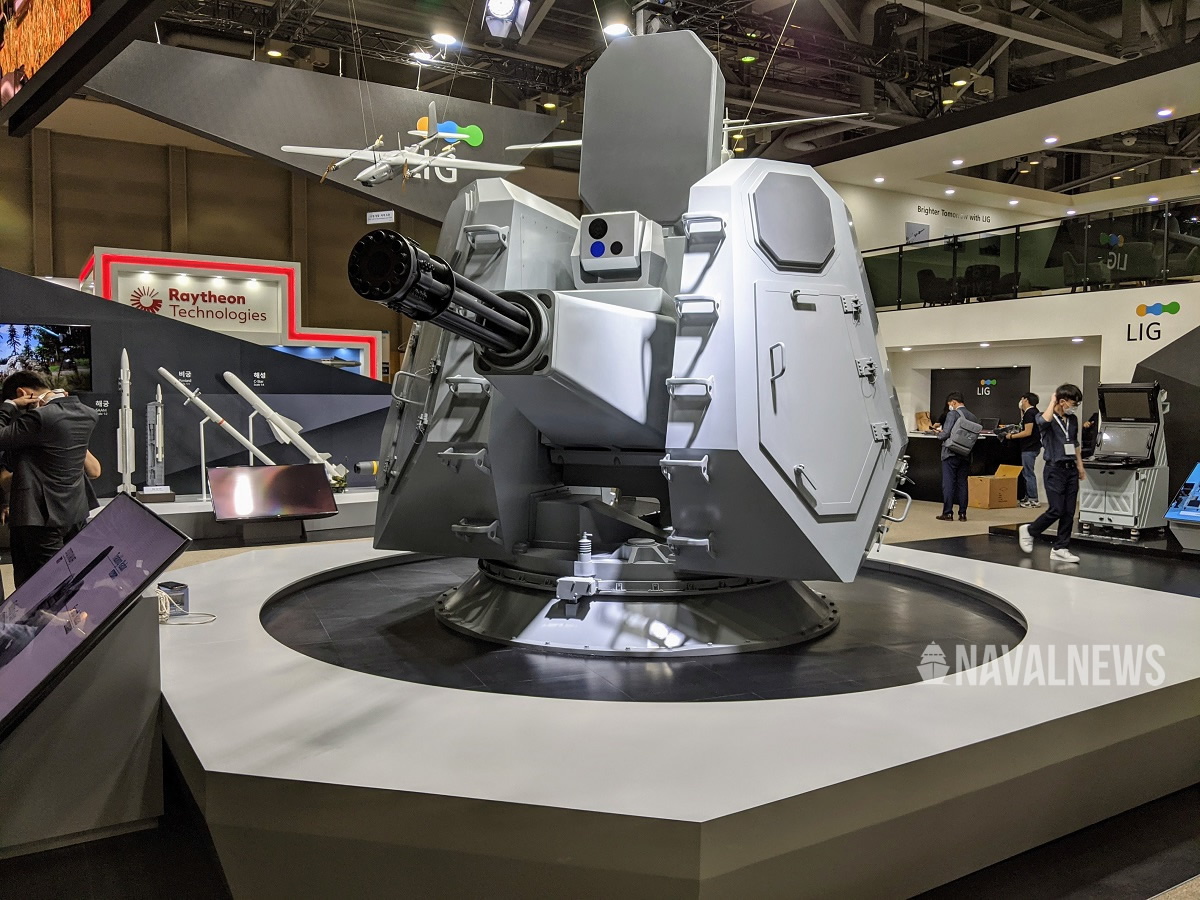
MADEX 2021: LIG Nex1 Unveils its CIWS-II for ROK Navy - Naval News
Korean company LIG Nex1 unveiled its CIWS-II (close-in weapon system) design during MADEX 2021 naval defense exhibition currently held in Busan. LIG Nex1 is specialized in localized naval assets including sonars, sensors, missiles, and other assets for the Republic of Korea Navy (ROKN).
An artist's rendering of the M80 ASW variant showcased at MADEX 2021
Aron, Sonartech Team Up For M80 Seaplane ASW Variant Development
Aron and Sonartech have teamed up to produce an anti-submarine warfare variant of the Aron M80. In an interview with Naval News, Vice-president of Aron, Young-yun Jun, explained the capabilities of this new aircraft.
Juho Lee 11 Jun 2021“The plane is an extremely effective anti-submarine platform because it is very cost efficient,” said Jun. The M80 can carry 24 Sonartech sonar buoys, has a maximum flight speed of 250 kilometers per hour, and a range of 800 kilometers. The M80 launches the buoys into the ocean in order to detect submarines. “This frees up much more expensive platforms, such as the P-8 Poseidon, allowing them to conduct other operations.”
Moreover, the Sonartech Side Sonar, installed below the cockpit, allows the plane itself to act as a surveillance vessel when afloat. “Because the plane is still in the development phase for now, we’re even looking into ways to make the sonar retractable,” said Jun.
Jun stressed that, although the seaplane is primarily designed to assist in anti-submarine warfare, he believes the plane is versatile enough to be used in a wide array of missions. “It’s maximum sailing speed is 120 kilometers per hour. Cruise sailing speed will be somewhere between 50 and 60 kilometers per hour. This makes it faster than most naval ships out there. Coupled with the fact that it can carry up to 16 LIG Nex1 70 mm Bigung (비궁) Low cOst Guided Imaging Rockets, we expect the platform to be an effective weapon against fast small combatants, such as North Korean missile boats. Moreover, the civilian variant is already operational, while the medical variant is also under development.”
An artist’s rendering of the M80 ASW variant showcased at MADEX 2021
The plane is expected to have very high mission readiness rates as well. Jun explained that the plane could set sail within 15 minutes of an emergency arising and within five minutes of engine ignition.
According to Jun, the company has already started talks with several nations regarding export. “Posco International is actually in charge of marketing for us because they’re the second largest shareholder. We’re engaged in talks with 12 different countries, including Turkey, Italy, Saudi Arabia, and Indonesia.”
The company is expected to start production next February. “We acquired a 130,000 square meter plot of land in Gyeongsangnam-do for this purpose. We hope to be exporting advanced technology while also creating jobs along the way.”
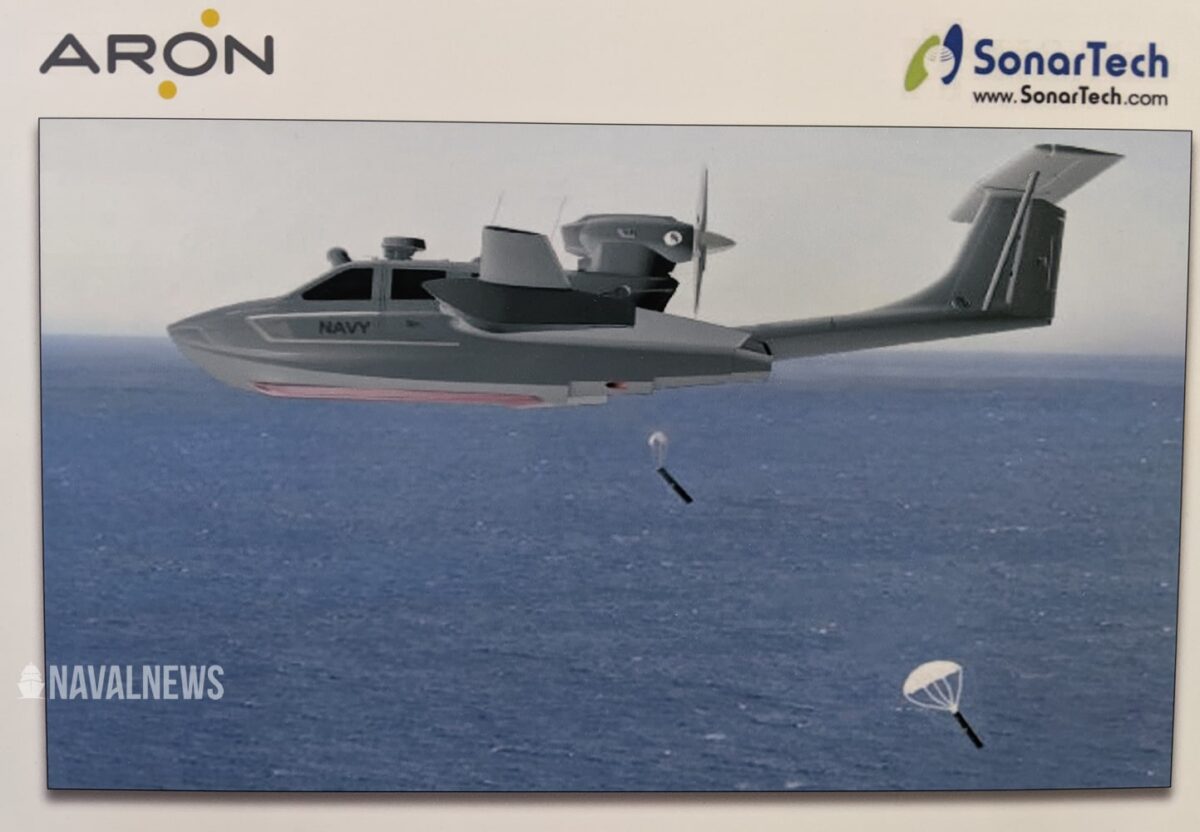
Aron, Sonartech Team Up for M80 Seaplane ASW Variant Development - Naval News
Aron and Sonartech have teamed up to produce an anti-submarine warfare variant of the Aron M80. In an interview with Naval News, Vice-president of Aron, Young-yun Jun, explained the capabilities of this new aircraft.

MADEX 2021: Sensorpia Magnetic Field Detection Systems - Naval News
Sensorpia produces many of the vital sensor technologies that are utilized by major South Korean companies, such as LIG Nex1, and the Republic of Korea Navy (ROKN). Naval News interviewed Dr Derac Son, the CEO, at MADEX 2021.
Day 3 at MADEX 2021, the maritime defense exhibition held in Busan, South Korea. In this video we cover new sonar systems by local company Sonartech, KAI's Marine Assault Helicopter (MAH), Mine Countermeasures Helicopter (MCH) and rumors of a naval variant of the KF-21 fighter for the CVX. We also talk naval decoys with Lacroix and its local partner TS Tech, we look at what's on display on the Raytheon booth and we discuss British cooperation for the CVX program with Babcock.

The new CWIS uses an actively scanned electronic array (AESA) radar. “The AESA radar is the one that will equip the KF-21. The system actually has two separate AESA radar systems,” explain a Hanwha representative during an interview with Naval News. The radar at the back keeps a lookout for incoming threats. The radar above the barrel at the front is the fire control radar.
The electro optical targeting system (EOTS) is another new feature. “We completed development of EOTS in 2017,” explained the representative. He claimed that the new EOTS will allow for even greater precision. “Previous CWIS systems did use the EOTS. However, they were only used to confirm hits, not as a fire control sensor. In the new CWIS, the EOTS augments the AESA radar in tracking and destroying incoming missiles.”
The new design also uses an advanced “ballistic calculator (BC)”. “The improved BC allows us to fire with greater precision, making the system much more effective than previous iterations.”
The most notable aspect of the new design is stealth. The system features many sleek angled surfaces; most of the gun’s barrel has been covered so as to minimize radar cross section.
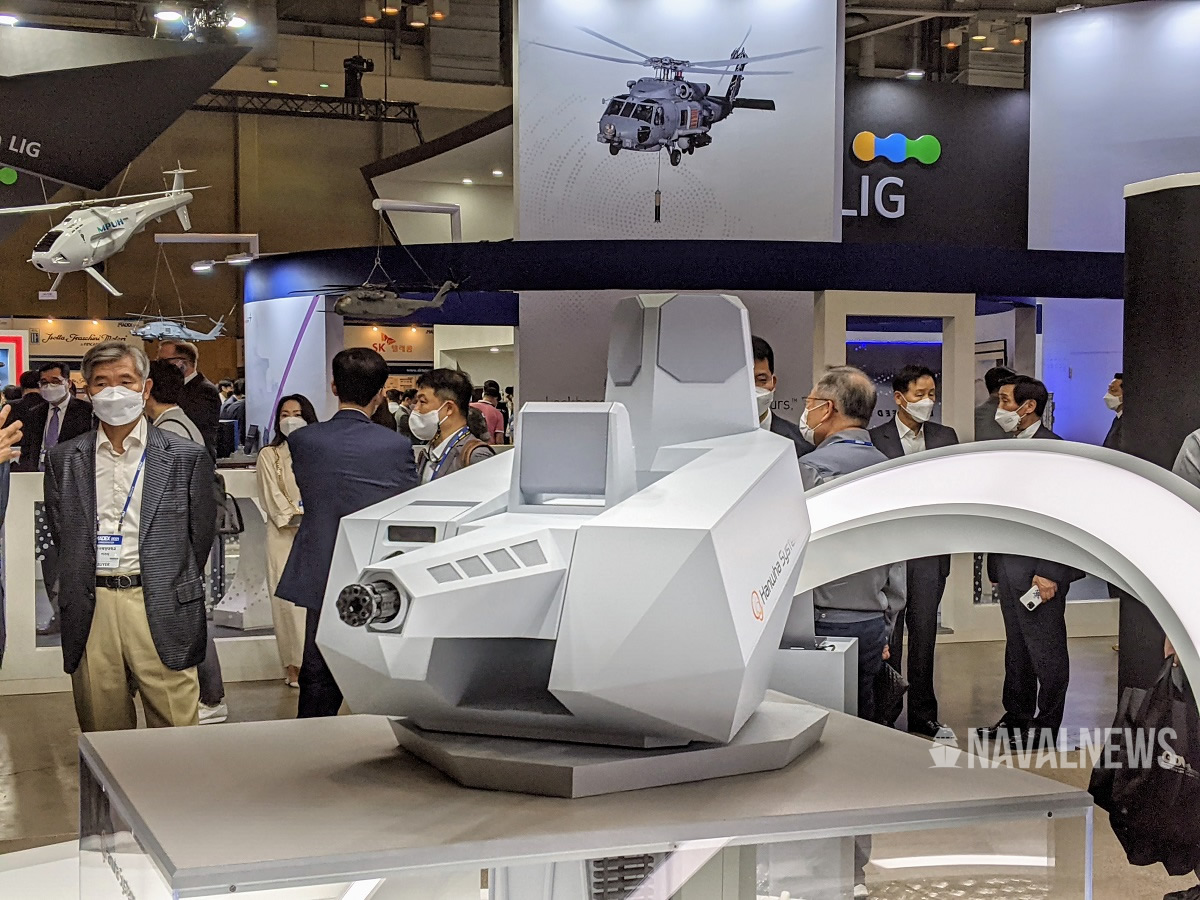
 www.navalnews.com
www.navalnews.com
MADEX 2021: Hanwha Rolls Out CIWS-II Design For ROK Navy
Hanwha Systems unveiled its design for the Republic of Korea Navy (ROKN)’s new CWIS-II program at MADEX 2021. It claims that the new design will provide a marked improvement over past systems.
Juho Lee 11 Jun 2021The new CWIS uses an actively scanned electronic array (AESA) radar. “The AESA radar is the one that will equip the KF-21. The system actually has two separate AESA radar systems,” explain a Hanwha representative during an interview with Naval News. The radar at the back keeps a lookout for incoming threats. The radar above the barrel at the front is the fire control radar.
“This AESA radar is highly advanced. By utilizing it, the system can track and intercept small supersonic targets that are travelling at upto mach 3.”
Hanwha Systems representative
The electro optical targeting system (EOTS) is another new feature. “We completed development of EOTS in 2017,” explained the representative. He claimed that the new EOTS will allow for even greater precision. “Previous CWIS systems did use the EOTS. However, they were only used to confirm hits, not as a fire control sensor. In the new CWIS, the EOTS augments the AESA radar in tracking and destroying incoming missiles.”
The new design also uses an advanced “ballistic calculator (BC)”. “The improved BC allows us to fire with greater precision, making the system much more effective than previous iterations.”
The most notable aspect of the new design is stealth. The system features many sleek angled surfaces; most of the gun’s barrel has been covered so as to minimize radar cross section.
“We built in stealth to help reduce the radar cross section of whichever ROKN ship the system is deployed on. If we win the contract, mass production is expected to begin around 2025.”

MADEX 2021: Hanwha Rolls Out CIWS-II Design for ROK Navy - Naval News
Hanwha Systems unveiled its design for the Republic of Korea Navy (ROKN)’s new CWIS-II program at MADEX 2021. It claims that the new design will provide a marked improvement over past systems.


